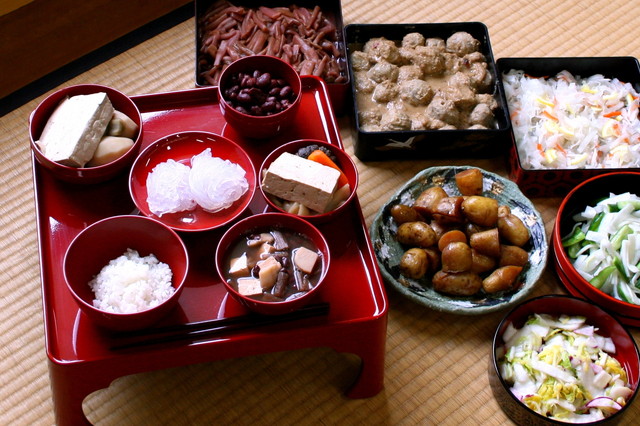Houon-ko cuisine (cuisine served at a Buddhist memorial service) | Our Regional Cuisines
-
Toyama Prefecture
Houon-ko cuisine (cuisine served at a Buddhist memorial service)
These images of local cuisine may not be downloaded.
-

Image source: Gokayama General Information Center
-

Image source: Gokayama General Information Center
-
Main lore areas
All of Toyama prefecture
-
Main ingredients used
Vegetables, wild plants, grains
-
History/origin/related events
Toyama Prefecture is known as the "Shinshu Kingdom" and is home to a thriving Jodo Shinshu sect. On the anniversary of the death of Shinran Shonin, the founder of Jodo Shinshu, Hoyo and Houon-ko are held to remember his legacy, and 'Houon-ko cuisine' is served on a vermilion-lacquered table.
The types and number of dishes vary from region to region, but it is customary to save the best vegetables and wild plants harvested that year for Houon-ko, apart from for everyday use. The Jodo Shinshu sect was introduced to the Hokuriku region during the Kamakura period (1185-1333), and it is said that the sect spread throughout the Etchu region from its base at Zuisenji Temple in present-day Nanto City.
For this reason, even today, the area around Nanto City is a particularly faithful area, where the Houon-ko is called "Honko-sama," and a variety of dishes are prepared in such a way that there is no way to fill all the dishes on the table. In the Gokayama area, where traditions are still deeply rooted, the dishes include bracken, royal ferns, and other wild vegetables picked in the spring and dried for preservation, “Gokayama Tofu”, which is firm enough to be tied with a rope without losing its shape, stewed Red Turnips, Red Turnip pickles, and New Rice, among other things. -
Opportunities and times of eating habits
On or around November 28, the anniversary of the death of Shinran Shonin, when monks were invited to temples and homes for a” Houon-ko” ceremony, people gathered around the” Gozen “and ate. Simmered dishes, soup, pickles and Rice are prepared, and” Adzuki” beans, which were” Shinran Shonin's favorite food, are always included. "Itoko-ni" and “Shira-ae”, which are standard “Houonkou “dishes, are also eaten at everyday meals.
-
How to eat
The contents of the dishes and the arrangement of the bowls and the way they are called differ from region to region and from family to family, but in the Gokayama area, rice, soup, vinegared dishes, simmered dishes, and jars are lined up on a bright vermilion-lacquered table. In addition, other dishes that do not fit into the bowl, such as pickled red turnips, are served in stacked boxes or large bowls. These are called "Otoshi," "Mawashi-bachi," or "strong bowl".
-
Efforts for Preservation and Succession
(Outline of the traditions, the preservation society, social media use, modern approaches to commercialization)
Since there are fewer areas where “Houon-ko” dishes are prepared than in the past, some inns in Nanto City are working to preserve this traditional event food by offering accommodation plans that allow guests to taste” Houon-ko” dishes. In addition, School lunches are also prepared with menus that incorporate dishes served during the Houon-ko occasion.
Contact
Food Cultures Office, Overseas Market Development and Food Cultures Division, Food Industry Affairs Bureau, Ministry of Agriculture, Forestry and Fisheries
Tel:+81-3-3502-5516





